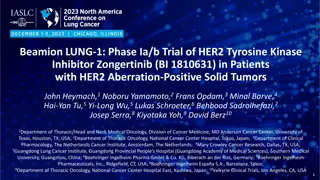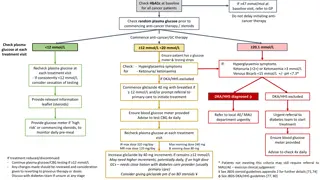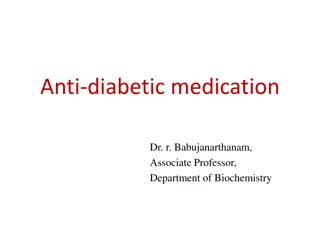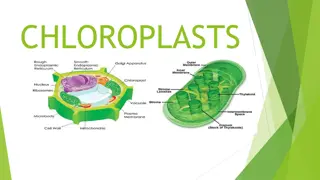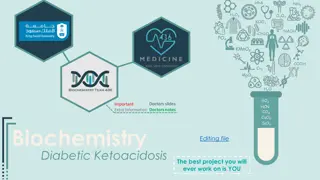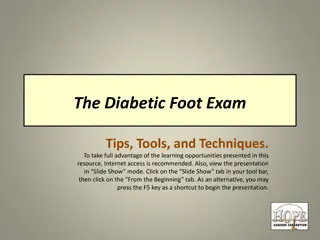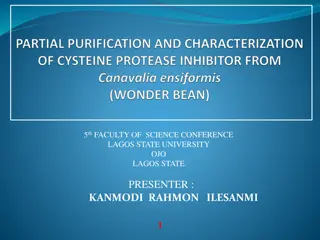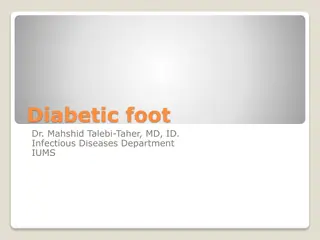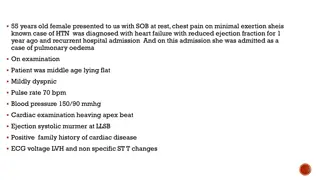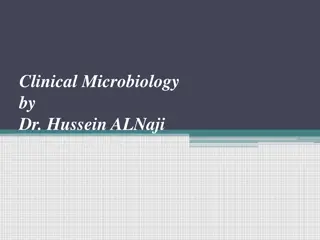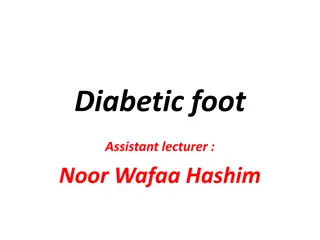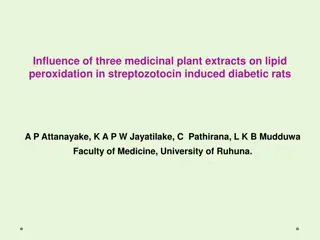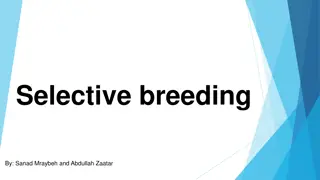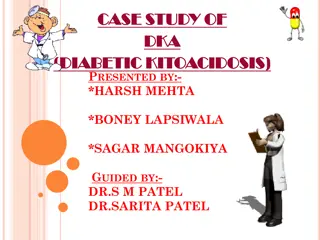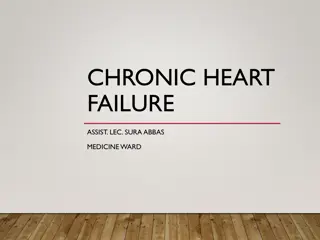Selective Aldose Reductase Inhibitor for Diabetic Cardiomyopathy Treatment
The ARISE-HF study presents primary results on the effectiveness of a selective aldose reductase inhibitor in treating diabetic cardiomyopathy, a common complication of diabetes mellitus leading to heart failure. The study highlights the increased risk of heart failure in individuals with diabetes, with diabetic cardiomyopathy contributing to this elevated risk. The pathogenesis of diabetic cardiomyopathy involves hyperactivation of the polyol pathway due to high glucose levels, leading to cell death and oxidative stress. The findings underscore the potential of targeted aldose reductase inhibition as a therapeutic approach for managing diabetic cardiomyopathy and reducing the burden of heart failure in diabetic patients.
Download Presentation

Please find below an Image/Link to download the presentation.
The content on the website is provided AS IS for your information and personal use only. It may not be sold, licensed, or shared on other websites without obtaining consent from the author.If you encounter any issues during the download, it is possible that the publisher has removed the file from their server.
You are allowed to download the files provided on this website for personal or commercial use, subject to the condition that they are used lawfully. All files are the property of their respective owners.
The content on the website is provided AS IS for your information and personal use only. It may not be sold, licensed, or shared on other websites without obtaining consent from the author.
E N D
Presentation Transcript
A Selective Aldose Reductase Inhibitor for the Treatment of Diabetic Cardiomyopathy Primary Results of the Phase 3 Randomized Controlled ARISE-HF Study James L. Januzzi Jr, MDa, Javed Butler, MD, MPH, MBAb,c, Stefano Del Prato, MDd, Justin A. Ezekowitz, MB, BChe, Nasrien E. Ibrahim, MD, MPHf, Carolyn S.P. Lam MBBS, PhDg, Gregory D. Lewis, MDh, Thomas H. Marwick, MBBS, PhD, MPHi , Riccardo Perfetti, MD, PhDj, Julio Rosenstock, MDk , Scott D. Solomon MDf, W.H. Wilson Tang, MDl, Faiez Zannad, MD, PhDm aCardiology division, Massachusetts General Hospital, Baim Institute for Clinical Research and Harvard Medical School, Boston, MA, USA; bUniversity of Mississippi Medical Center, Jackson, MS, USA; cBaylor Scott and White Institute, Dallas, TX, USA; dInterdisciplinary Center Health Sciences , Sant Anna School of Advanced Studies, Pisa, Italy; eDivision of Cardiology, University of Alberta, Canada; fBrigham and Women s Hospital, Harvard Medical School, Boston, MA, USA; gNational Heart Centre Singapore and Duke-National University of Singapore, Singapore, Baim Institute for Clinical Research, Boston, MA, USA; hCardiology Division, Massachusetts General Hospital, Harvard Medical School, Boston, MA, USA; iBaker Heart and Diabetes Institute, Melbourne, Australia; jApplied Therapeutics, New York, NY, USA; kVelocity Clinical Research Center at Medical City, Dallas, TX, USA; lHeart, Vascular and Thoracic Institute, Cleveland Clinic, Cleveland, OH, USA; mUniversit de Lorraine, Inserm CIC and CHRU, Nancy, France. Harvard Medical School
Disclosures Dr. Januzzi: Board member ACC, Imbria Pharma Grant support from Abbott, Applied Therapeutics, AstraZeneca, BMS, Novartis Pharmaceuticals Consulting income from Abbott Diagnostics, Beckman-Coulter, Jana Care, Janssen, Novartis, Prevencio, Quidel, and Roche Diagnostics Clinical endpoint committees/data safety monitoring boards for Abbott, AbbVie, Amgen, CVRx, Medtronic, Pfizer, and Roche Diagnostics The ARISE-HF Trial was sponsored by Applied Therapeutics, Inc
Introduction Heart failure (HF) is a major cardiovascular complication among individuals with diabetes mellitus (DM) Persons with DM have 2X risk for HF development HF onset is often heralded by decline in exercise capacity Risk for HF persists even when adjusting for presence of classical risk HF risk factors DM itself may result in heart muscle disease, known as diabetic cardiomyopathy (DbCM)
Pathogenesisof DbCM & Hyperactivation of Polyol Pathway1,2 Hexokinase Glucose-6- Phosphate Glycolitic Pathway Glucose Normal (Krebs Cycle) Hyperglycemia / Ischemia (Polyol Pathway Activated) Aldose Reductase Osmotic stress CELL DEATH Sorbitol Sorbitol Dehydrogenase Redox Imbalance ROS Formation Advanced Glycation PKC, NF-kB* Activation CELL DEATH Fructose 1. Brownlee M. Diabetes Care. 2005;54(6):1615-1625. 2. Miki T, et al. Heart Fail Rev. 2013;18(2):149-166.
Blocking aldose reductase in DBCM Aldose reductase inhibitors (ARIs) had previously been developed for treatment of microvascular complications Most 1st generation ARIs were low potency and poorly tolerated due to side effects AT-001 is a highly potent and well-tolerated ARI Januzzi JL Jr, Butler J, Del Prato S, et al Am Heart J. 2023 Feb;256:25-36.
Hypothesis Treatment of individuals with DbCM and reduced exercise capacity at high risk for HF with an Aldose Reductase Inhibitor (AT-001) would limit progression of DbCM reflected in stabilization of peak VO2 Januzzi JL Jr, Butler J, Del Prato S, et al Am Heart J. 2023 Feb;256:25-36.
Key Inclusion/Exclusion Criteria Inclusion Exclusion To be included, participants had T2DM and: Diagnosis of T2DM On stable glucose lowering and RAS inhibition Age 60 years or Age 40 to < 60 years and either duration of T2DM 10 years or eGFR< 60 mL/min DbCM/Stage B HF with at least 1: GLS < 16% Increased LVMi LAVi > 34 mL/m2 E/E 13 RVSP> 35 mmHg NT-proBNP 50 ng/L hs-cTnT 6 ng/L Peak VO2 < 75% of predicted RER 1.05 Known or suspected Stage C HF Loop diuretic use BP > 140/> 90 mmHg HbA1c >8.5% Prior ACS Severe CAD Prior CABG or PCI Severe valvular heart disease Clinically significant arrhythmia including permanent AF or PAF requiring hospitalization Prior stroke BMI 45 kg/m2 Stage B HF Reduced exercise capacity No known ASCVD, valvular heart disease, or arrhythmia Study participants were required to have: Controlled blood pressure HbA1c <8.5% Januzzi JL Jr, Butler J, Del Prato S, et al Am Heart J. 2023 Feb;256:25-36. 7
Study Design Screening Study completion: 15 months AT-001 1500 mg A sample size of 181 patients per treatment group was calculated to provide the analysis >90% power to detect a difference in peak VO2 of 1.2 mL/kg/min CPET CPET AT-001 1000 mg R Placebo Twice-daily oral dosing Inclusion stratified by region, baseline CPET result, and use of SGLT2 inhibitor or GLP-1RA Owing to COVID-19 related delays, a planned extension to 27 months if the primary endpoint was neutral at 15 months was removed CPET denotes: cardiopulmonary exercise test; SGLT2 denotes: sodium/glucose cotransporter 2; GLP-1RA denotes: glucagon like peptide receptor agonist-1 Januzzi JL Jr, Butler J, Del Prato S, et al Am Heart J. 2023 Feb;256:25-36. 8
Endpoints Primary endpoint: change in peak VO2 from baseline to 15 months between placebo and high dose AT-001 Prespecified sub-groups: 1. Region of enrollment 2. Sex 3. CPET parameters (peak VO2, RER) 4. Hemoglobin A1c 5. Baseline NT-proBNP and/or hs-cTnT 6. Baseline use versus non-use of SGLT2 inhibitor and/or GLP-1 RA Januzzi JL Jr, Butler J, Del Prato S, et al Am Heart J. 2023 Feb;256:25-36.
Endpoints Key secondary endpoints: Percentage of study participants with 6% decrease in peak VO2 Change in NT-proBNP concentration Change in Kansas City Cardiomyopathy Questionnaire (KCCQ) score Change in activity using the Physical Activity Scale for the Elderly (PASE) Progression to symptomatic HF events Composite of CV death, HF hospitalization or development of signs/symptoms of HF Based on adjudicated endpoints plus adverse event reporting using Medical Dictionary for Regulatory Activities (MedDRA) preferred terms Januzzi JL Jr, Butler J, Del Prato S, et al Am Heart J. 2023 Feb;256:25-36.
Baseline characteristics AT-001 1000 mg (N=230) AT-001 1500 mg (N=231) Placebo (N=230) Average age of 68 years 68.2 6.7 67.4 7.8 66.9 7.0 124 (53.9) 107 (46.5) 117 (50.6) Age, years Female, n (%) Race, n (%) White Black Hispanic ethnicity, n (%) Body-mass index, kg/m2 SBP, mmHg Medical history, n (%) Hypertension Dyslipidemia Duration of T2DM, years SGLT2i or GLP-1RA, n (%) Female predominant (50.4%) Race and ethnicity reflective of international enrollment 195 (84.8) 191 (83.0) 184 (79.7) 14 (6.1) 13 (5.7) 44 (19.1) 48 (20.9) 30.9 4.8 30.4 4.6 30.5 4.4 131 17 132 17 23 (10.0) 59 (25.5) Medical evaluation included a BMI of 31 but well-controlled blood pressure 131 16 Long-standing history of T2DM 179 (77.8) 179 (77.8) 165 (71.4) 45 (19.6) 36 (15.7) 14.4 9.2 14.6 9.2 14.4 9.0 86 (37.4) 89 (38.7) 62% were not receiving an SGLT2i or GLP-1RA at baseline 35 (15.2) 88 (38.1) SD denotes: standard deviation; kg denotes: kilogram; m2 denotes: square meter; SBP denotes: systolic blood pressure; SGLT2i denotes: sodium/glucose cotransporter 2 inhibitor; GLP1-RA denotes: glucagon-like peptide-1 receptor agonist 12
Baseline characteristics, objective results AT-001 1000 mg (N=230) 7.04 0.81 81 16 AT-001 1500 mg (N=231) 6.98 0.80 80 17 Well-controlled T2DM Placebo (N=230) Parameter Preserved kidney function 6.96 0.74 81 16 Hemoglobin A1c, % eGFR, mL/min/1.73m2 NT-proBNP, ng/L, median (Q1,Q3) 76 (42,145) 74 (39,137) 63 (27,114) hs-cTnT, ng/L, median (Q1,Q3) ~25% with high-risk NT- proBNP or hs-cTnT 8 (6,13) 9 (6,12) 9 (6,12) PASE consistent with reduced activity but with well-preserved KCCQ scores 159 94 90 16 90 15 92 15 150 90 90 15 91 14 92 15 157 87 91 13 91 13 94 13 PASE Score KCCQ Overall Summary Score KCCQ Clinical Summary Score KCCQ Total Symptom Score Impairment in exercise capacity with average peak VO2 of 15.7 mL/kg/min 132 (57.4) 15.6 3.8 131 (57) 15.7 3.8 131 (56.7) 16 3.9 Baseline RER 1.15, n (%) Baseline peak VO2,mL/kg/min Results are mean standard deviation unless otherwise specified eGFR denotes: estimated glomerular filtration rate; mL denotes: milliliters; min denotes: minute; NT-proBNP denotes: N-terminal pro-B type natriuretic peptide; ng/L denotes: nanograms/liter; hs-cTnT denotes: high sensitivity cardiac troponin T; PASE denotes: Physical Activity Scale for the Elderly; SD denotes: standard deviation; KCCQ denotes: Kansas City Cardiomyopathy Questionnaire; RER denotes: respiratory exchange ratio; VO2 denotes: oxygen consumption 13
Change in Peak VO2 by 15 months 0.4 Adjusted Peak VO2 Mean Change from Baseline +/- SE 0.2 0.0 -0.2 -0.4 -0.6 -0.8 Baseline peak VO2 = 15.7 3.8 -1.0 Baseline Month 15 14
Change in Peak VO2 by 15 months 0.4 Adjusted Peak VO2 Mean Change from Baseline +/- SE 0.2 Change AT-001 1500 mg: -0.01 (SE=0.18) P =.21 compared to baseline 0.0 -0.2 -0.4 -0.6 AT-001 1500 mg twice daily -0.8 Baseline peak VO2 = 15.7 3.8 -1.0 Baseline Month 15 15
Change in Peak VO2 by 15 months 0.4 Adjusted Peak VO2 Mean Change from Baseline +/- SE 0.2 Change AT-001 1500 mg: -0.01 (SE=0.18) P =.21 compared to baseline 0.0 -0.2 Change Placebo: -0.31 (SE=0.18) P =.005 compared to baseline -0.4 -0.6 AT-001 1500 mg twice daily -0.8 Baseline peak VO2 = 15.7 3.8 Placebo twice daily -1.0 Baseline Month 15 16
Change in Peak VO2 by 15 months 0.4 0.4 Adjusted Peak VO2 Mean Change from Baseline +/- SE Adjusted Peak VO2 Mean Change from Baseline +/- SE 0.2 0.2 0.0 0.0 LS-mean difference of change AT-001 vs Placebo = 0.30 (0.23) P =.19 -0.2 -0.2 -0.4 -0.4 -0.6 -0.6 AT-001 1500 mg twice daily -0.8 -0.8 Baseline peak VO2 = 15.7 3.8 Placebo twice daily -1.0 -1.0 Baseline Baseline Month 15 Month 15 17
Change in Peak VO2 in those not receiving SGLT2 inhibitors or GLP1-RA* *Prespecified subgroup and study participants stratified on enrollment 0.4 Adjusted Peak VO2 Mean Change from Baseline +/- SE 0.2 Change AT-001 1500 mg: +0.08 (SE=0.22) 0.0 LS-mean difference of change AT-001 vs Placebo =0.62 (0.30) P =.04 -0.2 -0.4 Change Placebo: -0.54 (0.21) -0.6 AT-001 1500 mg twice daily -0.8 Baseline peak VO2 = 15.7 3.8 Placebo twice daily -1.0 Baseline Month 15 18
Secondary endpoints A 6% decline in peak VO2 was observed in 41.8% of placebo-treated patients and 36.2% of those treated with high dose AT-001 (OR=0.80, 95% CI=0.52, 1.21; P =.29) Among non-users of SGLT2 inhibitors or GLP-1RA: 46.0% versus 32.7% (OR=0.56; 95% CI=0.33, 0.96; P =.04) No significant differences in change of NT-proBNP, KCCQ domains or PASE results were observed
Development of HF symptoms or signs 30 5 26 study participants in the placebo group vs 13 patients in the high dose AT-001 group developed symptoms or signs of HF (Chi-squared P =.03) Num er of Patients 0 15 10 5 0 Place o AT 001 1500mg
Safety, adverse events occurring in >5% AT-001 1000 mg 53 (23.2) 34 (14.9) 17 (7.5) 20 (8.8) 16 (7) 20 (8.8) 12 (5.3) 14 (6.1) 19 (8.3) 5 (2.2) 11 (4.8) 10 (4.4) 12 (5.3) 7 (3.1) 10 (4.4) AT-001 1500 mg 34 (14.7) 37 (16) 21 (9.1) 18 (7.8) 21 (9.1) 15 (6.5) 20 (8.7) 17 (7.4) 11 (4.8) 22 (9.5) 15 (6.5) 14 (6.1) 12 (5.2) 16 (6.9) 12 (5.2) Characteristic Overall Placebo 131 (19.0) 96 (13.9) 49 (7.1) 51 (7.4) 39 (5.7) 58 (8.4) 54 (7.8) 40 (5.8) 45 (6.5) 37 (5.4) 42 (6.1) 35 (5.1) 37 (5.4) 37 (5.4) 36 (5.2) 44 (19.1) 25 (10.9) 11 (4.8) 13 (5.7) 2 (0.9) 23 (10) 22 (9.6) 9 (3.9) 15 (6.5) 10 (4.3) 16 (7) 11 (4.8) 13 (5.7) 14 (6.1) 14 (6.1) COVID-19 UTI Constipation Nausea Decrease in eGFR Diarrhea Fatigue Back pain Nasopharyngitis Dizziness Arthralgia Headache URI Fall Peripheral edema AT-001 was generally well-tolerated Treatment with AT-001 was not associated with any evidence of significant liver injury Rise in serum creatinine at any time during the trial was infrequent and transient There was no imbalance in drug discontinuation due to deterioration of kidney function All results n (%); UTI denotes: urinary tract infection; eGFR denotes: estimated glomerular filtration rate; URI denotes: upper respiratory tract infection 21
Conclusions Treatment with AT-001 was safe and well-tolerated but did not result in a statistically significant difference in peak VO2 among persons with DbCM and reduced exercise capacity The study participants in ARISE-HF had very well-controlled T2DM (A1c=6.98%), which may not reflect persons with DbCM more generally A longer study duration might have been necessary More investigation is needed regarding the potential role of AT-001 to improve cardiovascular outcomes in this high-risk population Future studies should evaluate longer treatment with AT-001 in a more generalizable population of DbCM The finding of superior outcomes in those not receiving SGLT2 inhibitors or GLP-1RA is exploratory in nature but bears further study
Conclusions The investigators wish to thank our sites, investigators, and especially the patients for their participation in the ARISE-HF Trial ARISE-HF is online now at Available at: https://www.jacc.org/doi/10.1016/j.jacc.2024.03.380



